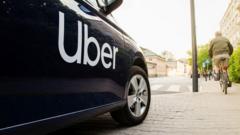Is Uber's Dynamic Pricing Hurting Drivers' Earnings?

Understanding Uber's Dynamic Pricing: Impact on Passengers and Drivers
The rise of ride-sharing apps like Uber has transformed urban transportation in unprecedented ways. However, a recent study from the University of Oxford has raised significant concerns regarding Uber's dynamic pricing model, revealing its implications for both passengers and drivers. With dynamic pricing, Uber adjusts fares based on real-time demand and supply, theoretically ensuring that rides are always available. Yet, this strategy may lead to increased fares for passengers while simultaneously reducing earnings for drivers. This article delves into the findings of the study, the mechanics of dynamic pricing, and the ongoing debate surrounding the fairness of this system.
The Dynamics of Dynamic Pricing
Dynamic pricing, commonly referred to as surge pricing, allows Uber to modify fares based on various factors, including time of day, demand for rides, and even weather conditions. While this model is designed to optimize service availability, it raises questions about fairness and transparency in the gig economy.
According to the recent study, which analyzed data from over 1.5 million trips and 258 drivers in the UK from 2016 to 2024, the introduction of a dynamic pricing algorithm in 2023 significantly altered the landscape for both parties involved. Key findings from the study include:
- Passengers now pay higher fares per trip.
- Drivers' earnings have noticeably declined.
- Uber's commission rate increased from about 25% to 29% since the introduction of the dynamic pricing model.
Passenger Experience: Increased Fares
For passengers, dynamic pricing often means shelling out more for rides, especially during peak times or in high-demand areas. This increase can be attributed to the algorithm's responsiveness to market conditions. When demand surges, the algorithm automatically raises fares, ensuring that more drivers are incentivized to hit the road. While this approach can lead to shorter wait times for riders, it also leads to a higher financial burden on passengers.
Several factors contribute to the increased fares:
- High Demand: During busy times, such as weekends or major events, surge pricing kicks in, leading to substantial fare hikes.
- Geographical Variability: In densely populated areas where demand often outstrips supply, prices are more likely to increase.
- Time Sensitivity: Fares can change based on the time of day, with late-night rides often costing more due to reduced driver availability.
Drivers' Earnings: A Declining Trend
On the flip side, the study reveals a troubling trend in drivers' earnings. As Uber's commission has increased, drivers have experienced a drop in their hourly income from over £22 to just above £19. This decline is compounded by the fact that many drivers are spending more unpaid time waiting for rides, which further diminishes their overall earnings.
Key contributors to this decline include:
- Higher Company Commission: The increase in Uber's cut means that a larger portion of each fare is retained by the company.
- Increased Waiting Time: Drivers are reporting longer wait times for passenger requests, leading to fewer paid rides per hour.
- Competition: As more drivers join the platform, the competition increases, often leading to lower earnings as drivers compete for the same passengers.
The Gap Between What Customers Pay and What Drivers Receive
The study highlights a widening gap between the fares that passengers pay and the earnings that drivers receive. Professor Reuben Binns, the lead author of the study, emphasized that "the higher the value of the trip, the more of a cut Uber takes. So the more the customer pays, the less the driver actually earns per minute."
This disparity raises ethical questions regarding the fairness of the gig economy model. Is it sustainable for platforms like Uber to profit at the expense of their drivers while simultaneously increasing costs for passengers? The implications are significant not just for the individuals involved but for the broader transportation ecosystem.
Uber's Response to the Study
In response to the findings of the University of Oxford study, Uber has contested several claims, arguing that they do not recognize the figures presented in the report. The company claims that all drivers receive a transparent breakdown of their earnings and have the opportunity to assess their potential income before accepting rides.
Uber has also highlighted that drivers in the UK earned more than £1 billion from January to March of the current year. They assert that their commission percentage has remained stable over the years and can vary based on multiple factors, including the time of week and specific driver performance.
Despite these assurances, drivers remain skeptical. Many argue that the increasing demands of the job, coupled with declining earnings, are unsustainable. This ongoing tension reflects a broader struggle between gig economy workers and the platforms that employ them.
The Gig Economy: Future Trends and Considerations
The rise of dynamic pricing models like Uber's is part of a larger trend in the gig economy, where flexibility and convenience often come at a cost. As more workers enter this space, the conversation surrounding fair compensation, transparency, and worker rights becomes increasingly pressing.
Several potential future trends and considerations are emerging:
- Regulatory Changes: As studies like this gain traction, there may be increased pressure on governments to regulate gig economy companies, ensuring fair wages and protections for workers.
- Technological Innovations: Advancements in technology may lead to more sophisticated algorithms that can balance the interests of passengers and drivers more equitably.
- Alternative Models: The rise of worker cooperatives and alternative ride-sharing models may offer new pathways for fair compensation and worker empowerment.
Conclusion: A Call for Fairness in the Gig Economy
The implications of dynamic pricing in ride-sharing services like Uber illustrate a crucial tension in the gig economy: the balance between profitability and fairness. As passengers increasingly bear the burden of higher fares, and drivers see their earnings dwindle, it becomes imperative for all stakeholders to engage in meaningful dialogue about the future of this industry.
As we move forward, the question remains: How can ride-sharing platforms like Uber ensure that their business models are sustainable and equitable for all parties involved? Addressing this question is vital for the long-term viability of the gig economy.
Frequently Asked Questions
What is dynamic pricing in ride-sharing?
Dynamic pricing, or surge pricing, is a model used by companies like Uber to adjust fares based on real-time demand and supply. This means fares can increase significantly during peak demand times.
How does dynamic pricing affect drivers' earnings?
With dynamic pricing, Uber's commission increases, which often results in lower hourly earnings for drivers. As fares rise for passengers, drivers receive a smaller percentage of the total fare.
What can be done to improve earnings for Uber drivers?
Potential solutions to improve drivers' earnings may include regulatory changes to ensure fair compensation, implementing more equitable commission structures, and exploring alternative business models that prioritize worker rights.
In conclusion, as we navigate the complexities of the gig economy, how can we create a balance that benefits both passengers and drivers? #Uber #DynamicPricing #GigEconomy
Published: 2025-06-29 07:00:08 | Category: technology



